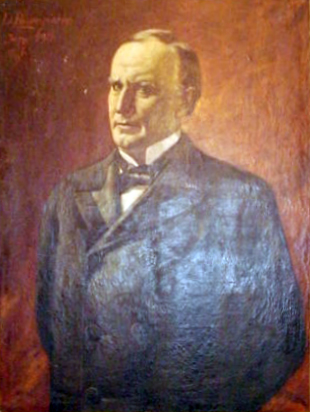Portraits
William McKinley
June 19th, 1896, dated in signature
Oil on canvas
6 x 4 ft., approximate
Whereabouts unknown
Elected to his first term of office on November 3, 1896, William McKinley was President of the United States from March 4, 1897, until September 14, 1901, when he was assassinated while attending the Pan-American Exposition in Buffalo, New York.
The painting is based on this photograph of McKinley taken in 1896 (probably a campaign photograph), though the eyes in the portrait look more like this photograph.
In the artist's signature, the painting is dated June 19, 1896, the first day of McKinley's "front porch" campaign, following his nomination to the Republican ticket.
However, I am not certain the painting was made in 1896. I suspect Buongiorno was commissioned, perhaps by a political club or other group sympathetic to McKinley, to make the painting for exhibit in Buffalo during the Pan-American Exhibition, as Buongiorno claimed participation in the Exhibition in his art biographies.
The painting was not exhibited in an official building of the exhibition, that I can determine—and records on the exhibition are extensive, so this is most likely definitive. Perhaps it was exhibited in a political building or local Republican office in Buffalo and Buongiorno was stretching the association to the Exhibition.
The painting may even have been commissioned after McKinley's assasination in September of 1901.
Buongiorno, who became a naturalized U.S. citizen in 1895, must have kept his politics to himself to acquire this commission, as I don't think he would have voted for McKinley.
Legislating controlling business activities was a significant political issue in the Gilded Age, trust-busting late 1800s. McKinley was in favor of using tariffs (taxes on imports) to shelter American industry from cheap imports. Buongiorno was anti-tariff, at least on art, because he had a side business as an art importer. When Buongiorno travelled to Italy (which he did every third year or so), he bought other artists' paintings to import to the U.S. for resale from his studio in New York.
Buongiorno told family members that he brought in the maximum value permitted without having to pay a tariff ($300 for most of the years around 1900) and made enough profit on this activity to pay for his own steamship tickets.
In 1908, Buongiorno even signed a petition to congress, along with other artists, collectors and dealers, opposing tariffs on imported art. This is his statement:

Leo Tolstoy
Circa 1890
Oil on canvas
5-1/2 x 5-1/4 in.
Private collection
This painting was owned by my grandfather and has descended in my family. The family story is that Leo Tolstoy visited Capri and the students at the art academy, where Buongiorno studied, were invited to sketch him. Later, Buongiorno painted the oil painting from the sketch.
Several Tolstoy scholars have confirmed to me that Tolstoy visited Europe, including Naples, in 1861, but never left Russia again after that trip. Buongiorno was born in 1865, which debunks the myth that Buongiorno sketched Tolstoy from life.
More likely, Buongiorno worked from a photograph.There were many images of Tolstoy in wide circulation in the late 1800s.
As this painting does match what Tolstoy looked like, the best purpose it serves for me is to confirm that Buongiorno was capable of painting an accurate likeness. Based on this (and his likeness of McKinley which is also accurate), I believe Buongiorno’s representations of "real people" models were also accurate, and I hope readers who recognize the people will identify them for me.

Was this painting exhibited at the Pan-American Exposition of 1901 in Buffalo, New York?
Donatus Buongiorno's art biographies list him as being involved in the exhibition, but I have not been able to identify what he showed.
He did not have work accepted in the juried fine art show, nor did he have any paintings exhibited in the fine arts building.
This painting is large: 3 feet by 4 feet. Perhaps it was displayed in a political exhibit somewhere on the grounds.
If you know anything about the exhibition's political exhibits or have other ideas about this painting, please contact me.


